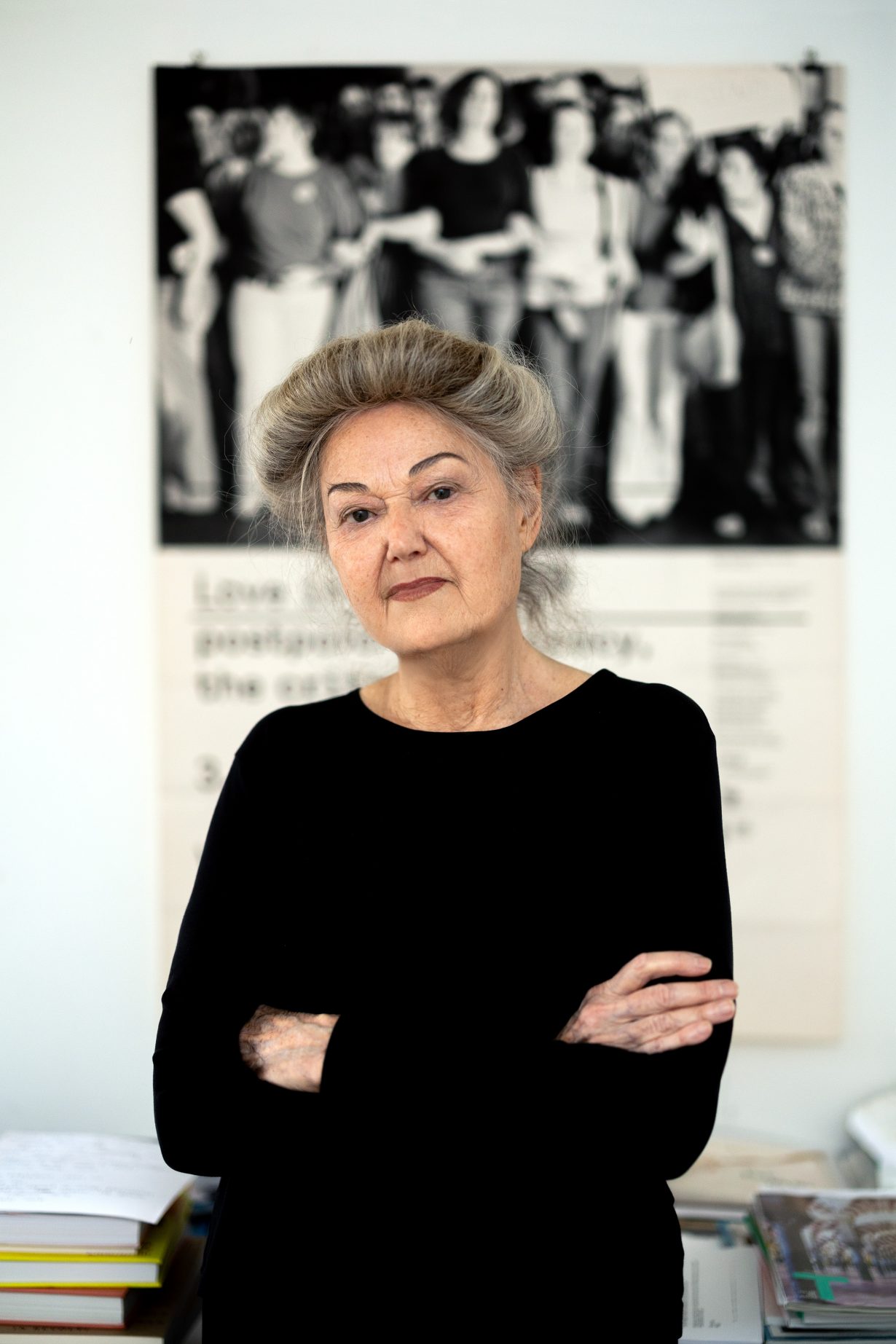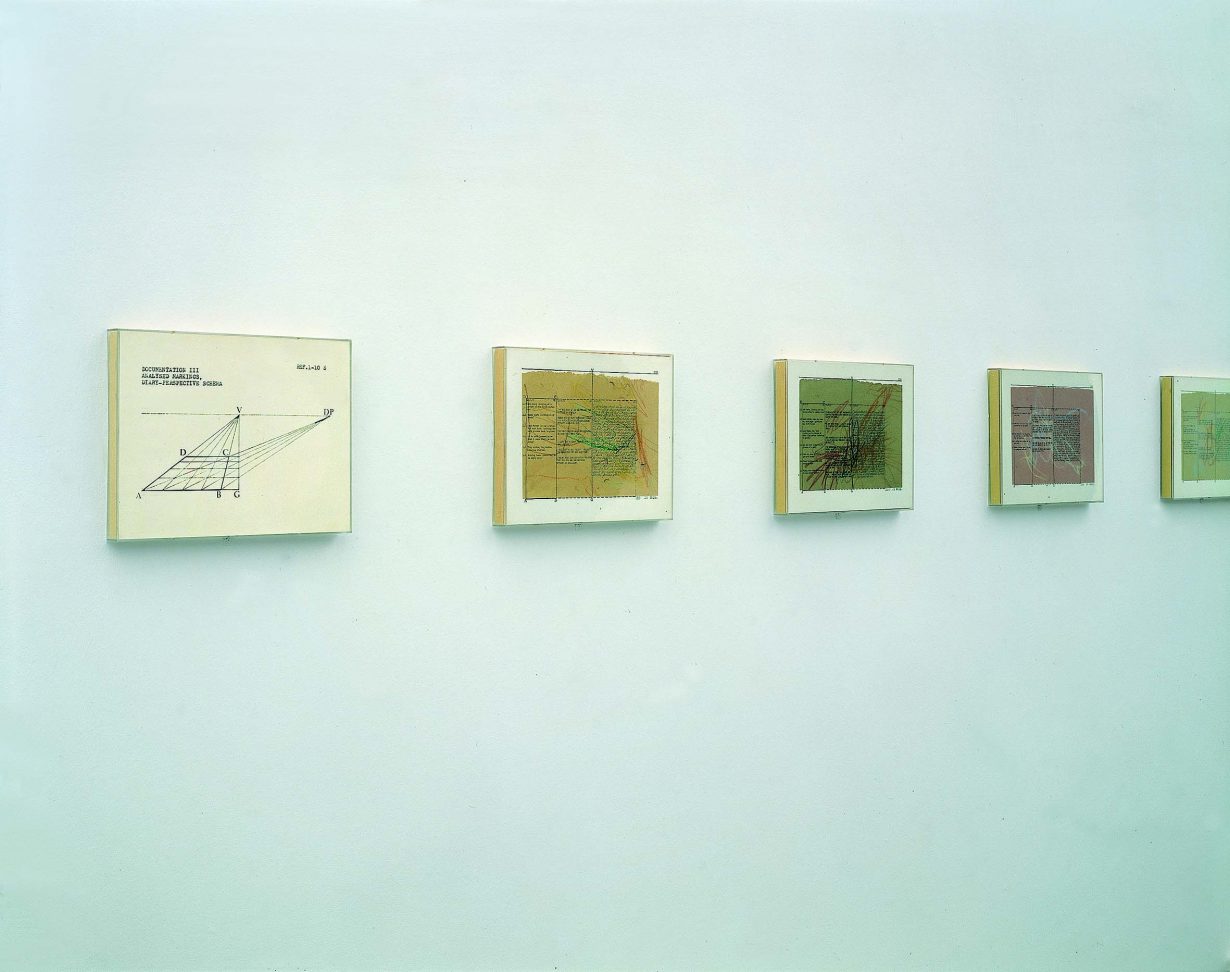As she opens a new exhibition of her work, the artist speaks about war, its relationship to gender, and hope
Over the past fifty years, American artist Mary Kelly has distilled her theoretical approach to feminism, and her own life experience, into a distinctive visual language. While at St Martin’s School of Art in London in the early seventies, Kelly became involved in film and in the women’s movement. This led to project-based works: durational and textual in nature, and often translated into large-scale installations, which both attend to, and transgress, post-war movements like conceptual art, process art and minimalism.
Between 1973 and 1976, Kelly undertook Post Partum Document, which chronicled the mother-child relationship she had with her son, and the mother’s eventual sense of loss or separation from the child as he becomes an autonomous being. Kelly applied conceptual art’s methodology to her own experiences, systematically documenting messy, unseemly things like breast feeding, faecal matter, and the child’s formation of language – rejecting, mocking even, the confines of empirical knowledge and its masculine structures. The project stopped at the moment when her child was able to write for himself.

Growing up in the shadow of Pearl Harbour and the nuclear arms race, Kelly’s corpus evolved from gender politics to the gender of war, with seminal works like Interim (1984-89) acknowledging the internalised masculinity of the women who went to the front line, while others like Mea Culpa (1999) and The Ballad of Kastriot Rexhepi (2001) documented what film theorist Laura Mulvey calls ‘the other side of the shield’ – or the civilian women and children targeted during conflict for their capacity to bear new life, and as emblems of new life.
As a current of right-wing authoritarianism bores its way through Europe and the US, and in light of ensuing genocides, a new exhibition of Kelly’s work opens in London with the title We don’t want to set the world on fire. At Pippy Houldsworth Gallery, Kelly bares witness to climate change, global conflict and its historical patternations but also speaks to the power of protest, not as something abstractly hopeful, but illuminating. This show is about systems and patterns: where they falter and how to break them. We spoke to Kelly about her own trajectory and how she came to arrive at this body of work.
ArtReview Like many people, I arrived at your work through Post-Partum Document (1973-79). What strikes me about it, and so much of your work, is its use of systems as compositional tools and formal ones, but also as subject matter – interrogating systems of logic, systems of language and power. Could we begin by talking about systems?
Mary Kelly In the so-called post-war period and leading up to the sixties, with minimal, process, conceptual art there was an attempt to get around the problem of composition, or what I came to call “creative essentialism”, of imagining it’s just you and that’s all that is available for the basis of the work. Rather than be dominated by stream of consciousness or improvisation, artists had to turn to systems, series and readymades. But this was a male dominated art-world and those systems didn’t have anything to do with life, as it were. So I started to talk about art that was about life, but I was filtering it through some of these formal mechanisms, like repetition.
I was also very influenced by linguistics and semiotics that came mostly from French theory, and by the work of French film duo Straub-Huillet who ran a whole reel of film, about 200 feet in one tracking shot – what you call “real time”. This strategy in film was comparable to what we were talking about in sculpture and conceptual projects – this idea of duration or what [British filmmaker and theorist] Peter Woollen termed for me, a ‘diegetic space’ where a story unfolds over documentary material as you move through the exhibition, so that there’s an accumulation of meaning rather than something that hits you all at once.

AR We don’t want to set the world on fire considers global conflict and personal experience. How did you arrive at these questions of war and its relationship to gender?
MK After Post-Partum, there was Interim (1984-89), which touched on aspects of the body in terms of its representation in the media, but at the same time raised questions that are more sociological about a women’s place in in society. It was the Gulf Wars, and I had this realisation that if women were in the military and asking to go to the front and kill the enemy, was that what we were aiming for in terms of equality? I had to consider that women had been internalising the masculine ideal. So works like Gloria Patri (1992) address this kind of production of aggression and masculinity that’s characteristic of war. There started to be this connection, in a psychological way, between the gender issue and the war issue.
But I felt you we shouldn’t be losing the maternal kind of relation, so my attention was directed towards the situation of women and children in the case of war. In Mea Culpa (1999), I started to deal with some of the stories about women and children that had been brought to the war crimes tribunal. That’s also when I started to use a new medium, compressed lint from the filter screen of my dryer, because I needed something so fragile, so ephemeral, so kind of othered in a way. The text in Mea Culpa was a very minimal narrative stripped of all adjectives, because I realised with the lint medium, the text is first of all an image. And that became the formal basis for more than 20 years of work that has dealt with those kinds of issues.

box frames, 6 units, 495 × 103 × 8 cm (overall). Courtesy the artist and Pippy Houldsworth Gallery, London
AR You present World on Fire Timeline (2020), a mixed media piece that gathers key moments of global conflict, and interpolates fragments of your older works, as well as personal ephemera, like letters from friends. Could you tell me a bit about that project, its intent, and how it came to be?
MK World on Fire Timeline (2020) was finished before the current situation in Ukraine and Gaza. There’s a chronological timeline running through all fifteen feet of the work, beginning with the Arms Race of 1949. I was born six months after Pear Harbour, at this juncture when there was the Women’s Strike for Peace, and thousands of women of my mother’s generation demonstrated against nuclear proliferation, using very innovative tactics, most famously an umbrella that said ‘peace is the only shelter’. I made a public work in the desert, where the original protests occurred, and enacted a performance with the umbrellas using three very well-known slogans from that movement: ‘we don’t want to set the world on fire’, ‘end the arms race, not the human race’ and then, of course ‘peace is the only shelter’.
One of the points of the work in this show is to look back at how much work has already been done. The timeline includes a doomsday clock, showing when resistance happens, change happens – for example, in 1963 when Kennedy signed the Non-Proliferation Treaty – the doomsday clock goes back a few seconds. Later, we can see that anti-war protest is aligning with climate issues, the clock goes back with the Paris Agreement of 2015 and then, just two years later, the Trump administration withdraws from that. At that point the clock goes to 100 seconds before doomsday.

AR But in Timeline, time itself contracts and extends and repeats itself, like a kind of anachronism.
MK The fragments and outtakes from all the previous lint works concerned with the subjects of war and protest represent an accumulation of memory and thought, but not in a linear way. I’ve also taken up the references to personal events included in the timeline, in works based on letters written to me by friends, two of which are in the show. Tucson, 1972 (2017) is about the Vietnam War and then the other London, 1974 (2017) is about the communal situation I lived in at the time in London, as if to say that it’s always politics in the context of these survival situations. Now people talk about it as micro-politics, which formalises the idea –– the personal is political. Sexual relationships, childcare, making a living, and finding alternatives became a question of feminist tactics, maybe some failed, but the question remains: what would a future informed by feminism looks like?
AR How does repetition function in the work and how does Timeline rekindle these older works that speak to ideas of conflict and protest?
MK Well perhaps we didn’t touch on psychological trauma, which generates repetition, and one of the important things that Freud says is that working through is the only way to surpass that. What do we need to do to break the cycle of repeating?
AR But there is a flip-side to repetition, and Gertrude Stein’s idea that it is only ever insistence. These works feel – hopeful isn’t the right word – but insistent in their message.
MK I kind of considered it my agenda to be the ethnographer of my moment, from the beginnings of the women’s movement, and the discourse I had with these women and the continuing question that our paths through have raised over time. For me it’s about asking the question, I think that’s the job description for an artist. Is there any hope?
Mary Kelly: We don’t want to set the world on fire is at Pippy Houldsworth Gallery, London, 14 November 2025 through 17 January 2026
Read next Mary Kelly: The Condition Of Women After Motherhood
